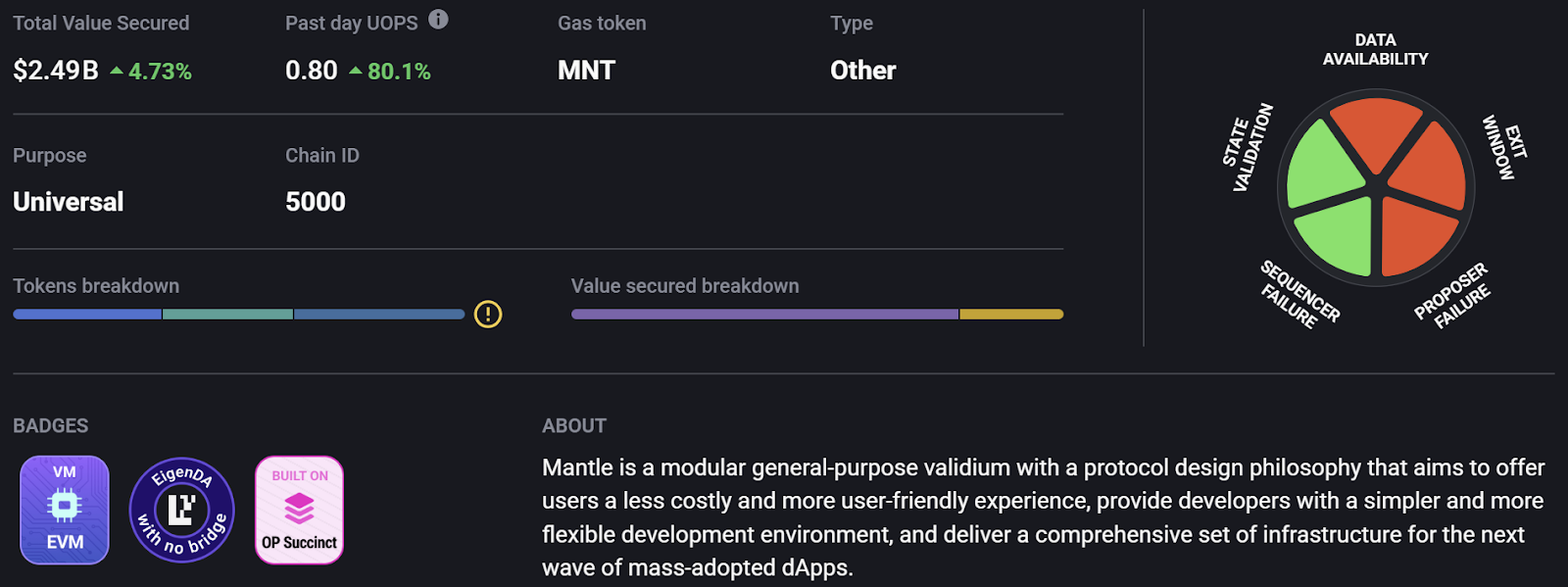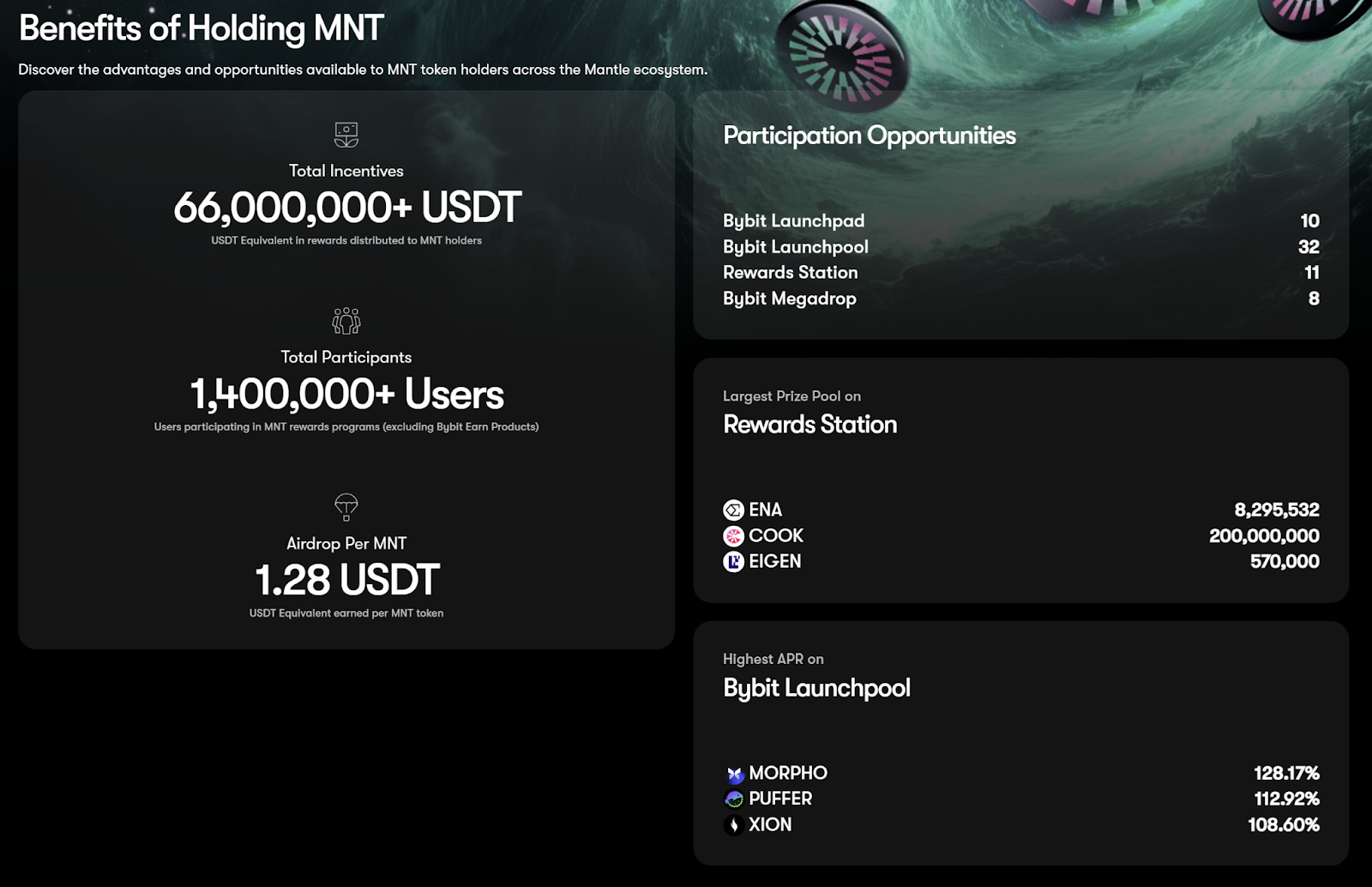The Bankless Guide to Mantle

Mantle — formerly BitDAO — is a Layer 2 (L2) scaling solution for Ethereum that deployed to mainnet in July 2023.
Among the best performing crypto projects in the second half of 2025, Mantle’s MNT token has surged 260% since the start of July, even though total value locked remained largely unchanged throughout the period.
Key Takeaways
- Mantle enjoys unique integrations with Bybit, affording MNT holders with similar centralized exchange ecosystem benefits to those received by BNB holders on Binance.
- MNT has outperformed peers in H2 2025, soaring 260% since July despite stagnancy in key onchain statistics, suggesting investors may be keying into Mantle’s exchange-backed advantage.
- Mantle is categorized as an “other” type rollup by L2BEAT. Users must fully trust a centralized entity, and risk loss of funds in the event the sequencer does not honestly relay available EigenDA data roots to Ethereum.
How Does Mantle Work?

Constructed using the flexible OP Stack L2 framework, Mantle mainnet transitioned from an optimistic rollup into a zero-knowledge validium powered by Succinct proofs this September.
Unlike traditional blockchains that execute transaction execution, consensus, settlement, and storage at the same network layer, Mantle is a modular chain that separates these functions into individual components. These include an EVM-compatible Mantle execution layer, an Ethereum consensus layer and settlement layer, and an external EigenDA data availability component.
While outsourcing data availability to EigenDA reduces transaction costs by more than 90%, L2BEAT classifies Mantle as an “other” rollup, noting centralization concerns and risk of fund losses as users rely on the sequencer to honestly relay available data roots to Ethereum.
Mantle uses MNT as its gas token, which only exists on the Ethereum and Mantle networks. To interact with Mantle, you’ll need to first acquire MNT on the Ethereum L1 to cover gas fees before bridging funds to the L2. This can be easily accomplished from many chains in one single transaction using popular bridge aggregators, like Jumper Exchange.
How Does Data Availability Work?
Data availability refers to the assurance that all transaction data is accessible to network participants. EigenLayer's EigenDA serves as the data availability layer for Mantle Network. Here's how it operates:
- Data encoding: Transactions processed by the Mantle execution layer are encoded into data chunks.
- Dispersal to DA Nodes: These data chunks are then distributed to DA nodes, which are responsible for storing the data securely.
- Attestation: DA nodes verify the integrity of the data chunks and provide cryptographic proofs of their availability.
- Aggregation and submission: Verified data proofs are aggregated and periodically submitted to the Ethereum mainnet, ensuring that the offchain data is accessible and verifiable.
This design approach significantly reduces transaction costs by keeping most of the data offchain while maintaining the security and integrity of the network through regular onchain attestations.
Why Mantle?

With an onchain treasury valued at approximately $7B, Mantle network wields the most valuable war chest of any DAO. Although 90% of this treasury is held as MNT tokens, the cache should be sufficient to fund ecosystem incentives, liquidity programs, and strategic investments for many years to come without external reliance.
Mantle also stands out for its close association with crypto exchange Bybit, which affords MNT holders with similar benefits as BNB does through Binance.
This special relationship provides its MNT token with unique utility support within the Bybit ecosystem. Holders receive access to the exchange’s incentivized earn pools (e.g.: Launchpad, Launchpool, Rewards Station, and Megadrop) and enjoy trading fee discounts.
How to Invest in Mantle?
MNT is the native token of Mantle. It derives inherent utility from its role as the network’s gas token and can be used in governance to direct Mantle’s product strategy, structure, tokenomics, official Committees, significant budget allocations, and governance parameters.
At the time of writing, MNT was trading around $2.40, implying a $14.9B fully diluted valuation and making Mantle the most valuable Ethereum Layer 2 in existence. While worth more than its six closest L2 competitors combined, Mantle is valued at less than one-tenth of fellow Binance-associated L1 blockchain BNB ($170B FDV).
MNT can be purchased or sold on various centralized cryptocurrency exchanges, including Bybit and Kraken. The token can also be purchased on decentralized exchanges on Ethereum L1 (like Uniswap) and Mantle L2 (like Agni Finance).
If purchasing MNT via an Ethereum DEX, remember to bridge it to Mantle to begin using the L2. This can be achieved using the official Mantle Mainnet Bridge.
Top Mantle Projects
The Mantle application ecosystem supports over 130 crypto products. Some of the top experiences to explore here include:
- 🔄 Agni Finance – currently the largest DEX on Mantle
- 🦍 ApeX Protocol – the leading Mantle perp DEX
- 🛸 Jumper Exchange – a popular bridge aggregator
- 🏦 Init Capital – the largest Mantle lending market
- 🧊 mETH Protocol – Mantle-backed ETH LST and LRT
- 🗺️ Mantle Missions – Mantle ecosystem quest rewards